Many of the Marche’s medieval hill towns were already thriving centres by the 15th century and most were left little unaltered when the Renaissance winds of change swept through the rest of Italy. As a result, this area boasts some of the finest early architecture in the whole of central Italy, such as the churches of San Claudio al Chienti and Santa Maria a Piè di Chienti which stand within a few kilometres of each other, as well as scores of perfect small medieval town centres.
This tour explores some of these places, taking in Sant’Elpidio a Mare and the tiny walled town of Monte San Giusto, before heading down past the worthy Fiastra Abbey to San Ginesio with its most handsome village square.
From here, we head back northwards to visit the miniature university city of Camerino, the picture-book town of San Severino Marche and the tomb of Saint Nicholas of Tolentino. We also stumble across relics of earlier settlements, including Roman amphitheatres at Urbisaglia and Villa Potenza. The trip starts and ends at Macerata, the capital of one of the Marche’s four provinces that stands just half an hour away from Ancona.
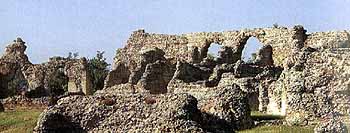
Helvia Recina - Villa Potenza
The Route
Part I - Macerata to San Ginesio
Macerata, world famous for its open-air opera festival, has several good hotels and makes an ideal base for this tour. Heading south from Macerata, follow the signs to Civitanova Marche. The route drops down into the broad valley of the Chienti river, then heads eastwards along the SS.485. Our first visit is to the Romanesque church of San Claudio al Chienti (just north of the main road) to see one of the Region’s earliest and most important churches. Its shape, quite unlike any other church in the Marche, is the first thing to strike you - it is in fact two churches, built one above the other, with separate entrances and flanked by two cylindrical towers. Created between the 5th and 7th centuries, probably on top of the ruins of a villa which formed part of the Roman city of Pausulae, it was built using material from the ancient ruins. Its present shape dates from the 11th and 12th centuries. Inside, both the upper and lower churches are square in form, and supported on four solid central pillars.
A few kilometres further east along the SS.485 lies another magnificent early church, Santa Maria a Piè di Chienti. This beautifully preserved Romanesque construction was built in the 9th century. Once again double-decker in form, this time the upper floor is built within the church at the further end of the high central nave. The 14th century frescoes in the apse above the upper altar are all the more powerful in their striking contrast with the remainder of the simple brick interior.
Leaving the modern development of the Chienti valley, we now head southwards to Sant’Elpidio a Mare. Despite its name, this worthy medieval town is not by the sea, but overlooks it from the safety of a hilltop stronghold. Through the Porta Marina and into the central Piazza Matteotti is the mighty Torre dei Cavalieri Gerosolimitani, together with two churches and the Town Hall - inside, the municipal art gallery has a magnificent 18-panel painting by Vittore Crivelli.
Passing Montegranaro (shoe factories now surround this hill town, though the centro storico still boasts some medieval architectural relics) we reach Monte San Giusto. The narrow streets of this town, like many others, were never designed for the motor car and you are well advised to park outside the town walls. Once inside, search out the Church of Santa Maria in Telusiano, a few metres from the pretty central piazza to see one of Lorenzo Lotto’s great masterpieces, a Crucifixion, painted in 1531 when the Venetian master was at the height of his career.
A few kilometres away in Corridonia, the Parish Art Collection, next to the Church of S. Pietro e Paolo (half way up via Cavour), houses another masterpiece, Carlo Crivelli’s Madonna with Suckling Child. You won't fail, however, to miss the town’s most conspicuous sight. The vast monument to Filippo Corridoni at the top of the town was built in the 1930s to honour a local First World War hero; the town, previously known as Pausola, was renamed Corridonia at the same time. The white Roman travertine stone hardly blends with the warm brick of the surrounding buildings but the monument undoubtedly stands as a striking example of the architecture of the period. Passing on through Petriolo (note the unusual stubby cylindrical gateway which the road passes through on its way out of the town) we drive into the gentler scenery of the Fiastra valley.
The noble old Fiastra Abbey, (open May-June weekends only; July- Sept daily) is one of the great Cistercian abbeys to be founded under the wing of Clairvaux in France. Apart from its splendid setting, it has delightful frescoes by the Salimbeni brothers and a fine Renaissance cloister. Part of the building now houses an archaeological museum with finds from the nearby Roman ruins of Urbs Salvia, and a collection of antique rural artefacts. The whole area is a Riserva Naturale, an idyllic spot for country rambles that is carefully protected by the World Wildlife Fund.
A few kilometres further south near Urbisaglia, stand the remains of Urbs Salvia. The city was founded in the 1st century BC and, like so many of the Marche's Roman towns, wiped out by Alaric in 408. For once this is an archaeological site with things you can actually see - the amphitheatre, built in the 2nd century AD, is one of the region's most conspicuous Roman ruins.
A little further on, drive up to San Ginesio, a delightful small town with a strong medieval stamp and breathtaking views of the mountains. The beautiful central square is named after the town’s most famous ancestor, Alberico Gentili (1552-1608), Professor of Civil Law at Oxford University and founder of the principles of International Law. His statue is overlooked by the splendid Collegiate Church - it’s Romanesque portal is topped by a highly unusual brick Gothic facade while the tower to one side has an oddly shaped onion dome sitting on it. Inside, visit the crypt which is decorated with delightful early frescoes by Lorenzo Salimbeni (1406).
|
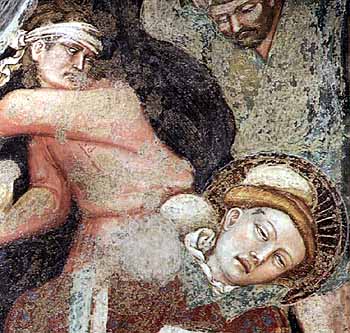
Chiesa Collegiata, cripta
S.Ginesio lapidato di Lorenzo salimbeni
|
Part II - San Ginesio to Camerino
Heading back northwards, we trace our way along country lanes, following the signs for Caldarola. As with so many other Italian towns, Caldarola is inextricably linked with the fortunes of one family. The Pallotta family produced four cardinals and reached its heyday in the last decade of the 16th century when Cardinal Evangelista Pallotta transformed the family castle into his summer residence. The family still own the castle, now open to the public (open 1000-1200hrs and 1500-1800hrs, closed Tuesday and Friday). The splendid Collegiate Church which stands nearby also dates from this period. Several paintings inside are by members of the De Magistris family, important local painters who lived here in the 16th & 17th centuries.
Our journey now takes us down to the busy main SS.77 and on towards Camerino but no wine enthusiast should lose the opportunity of making a 15 km detour to taste the sparkling red wine of Serrapetrona, which stands on the opposite side of the Chienti Valley. Vernaccia di Serrapetrona is normally a sweet dessert wine but is also produced in a drier secco version.
Back on the SS.77, we travel westwards as far as the proud ruins of the Rocca di Varano which stand guard over this stretch of the valley pass, before turning north to arrive at the noble university town of Camerino.
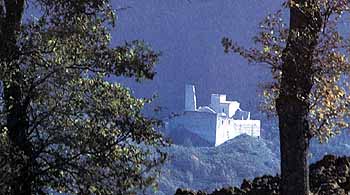
Castello di Varano - Camerino
Part III - Camerino to Tolentino
Leaving Camerino, we head north past Castelraimondo before turning eastwards. If you have time, visit the village of Gagliole, just north of the main road, with its well preserved 14th century walls and castle.
The tour now arrives at San Severino Marche. Founded around 550 AD after the Goths had destroyed the Roman settlement of Septempeda further down the hill, this homely town has a happy mix of Medieval and Renaissance buildings. Its outstanding feature is an unusual elliptical main square, Piazza del Popolo, which is circled by shady arcades. Search out the Pinacoteca, or art gallery, in Via Salimbeni 39, to see Pinturicchio's sumptuous Madonna della Pace and some endearing pictures by the brothers Lorenzo and Jacopo Salimbeni. You can see more of their work in the nearby Romanesque church of San Lorenzo in Doliolo and several other churches around the town.
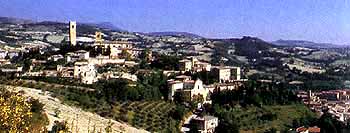
San Severino Marche
We now return briefly to the Chienti valley to visit the bustling market town of Tolentino and the basilica dedicated to its own saint, St Nicholas of Tolentino.
Part IV - Tolentino to Macerata
Just east of Tolentino, the swallowtail battlements of the Castello della Rancia come into view just off the main road. This solid square castle was built as a Benedictine abbey in the 12th century and transformed into a castle in 1357 for the ruling Da Varano family. It has been the scene of many battles, the last of which was the defeat of Giocchino Murat, the King of Naples, whose first 19th century bid to unify Italy was thwarted by Austrian troops in May 1815 - the battle is re-enacted each May in a colourful event with hundreds of extras. The castle has been recently restored and opened to the public.
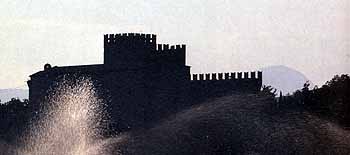
Castello della Rancia - Tolentino
Leaving the Chienti valley once again, we turn northwards to the delightful small town of Pollenza. Within its brick ramparts, the single main street, via Roma, strings together three intimate piazzas. The town is famed for antique furniture restoration and, as well as many workshops outside the walls, there are several shops here to browse around. At the far end of the town, the sumptuous Church of San Biagio, decked out in perfect neo-classical style, seems almost too grand for a place as unassuming as this. The town’s other claim to fame is the Marche’s only bust to the composer Verdi, which stands outside the theatre in Piazza della Libertà
Heading further north, the road crosses the valley of the River Musone to Treia, standing high on a long narrow hilltop. This papal stronghold was besieged during the wars against the Ghibellines.
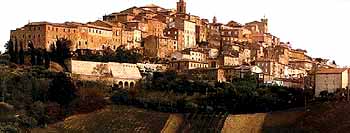
Treia
But nowadays its atmosphere is altogether more benign and the fortifications along its solid ramparts have been replaced with houses and balconies decked with washing. Torre Onglavina (or Torre di S. Marco) which stands mightily on a rocky spur, is all that remains of the castle. On a clear day it offers one of the most complete panoramas of the Marche region, from the Apennine mountains to the west as far as Monte Conero and Adriatic Sea to the east. The town has become famous for the annual Disfida del Bracciale, an ancient game of football played out in the first Sunday of August.
Returning to Macerata, pause just before Villa Potenza at the ancient remains of Helvia Recina.
When the Visigoths destroyed this Roman settlement in the 5th-6th Century, its inhabitants ran away to higher ground and founded the city of Macerata. Remains of the old city can still be seen, including the large amphitheatre, which stands just by the junction with the SS571, as well as a stretch of stone-paved roadway.
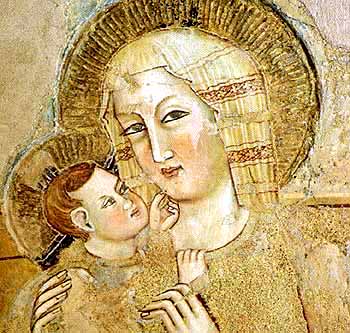
Museo Diocesano "Madonna Altino" XIV sec. - Camerino
Routes
Tour 1 - The Castles of Montefeltro
Tour 2 - From Paper to Stone
Tour 3 - The Vineyards of Verdicchio
Tour 4 - The Heartland of Le Marche
Tour 5 - In the Shadow of Monte Conero
Tour 6 - The Wild Mountains of the Sybil
Tour 7 - In the Footsteps of Ancient Rome
Tour 8 - Ascoli's Hidden Heritage
Tour 9 - Beside the Seaside
© Liberation Ventures Ltd.